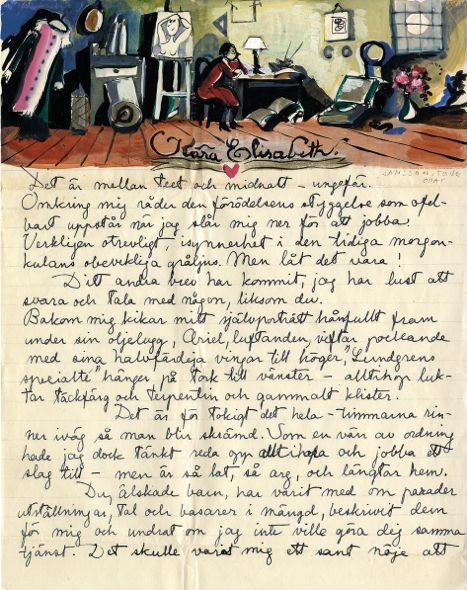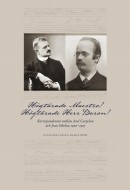Tag: correspondence
Letters from Tove
6 October 2014 | Extracts, Non-fiction

Early days: Tove Jansson went to Stockholm to study art when she was just 16. A letter to her friend Elisabeth Wolff, from November 1932
Artist and author Tove Jansson (1914–2001) is known abroad for her Moomin books for children and fiction for adults. A large selection of her letters – to family, friends and lovers – was published for the first time in September. In these extracts she writes to her best friend Eva Konikoff who moved to the US in 1941, to her lover, Atos Wirtanen, journalist and politician, and to her life companion of 45 years, artist Tuulikki Pietilä.
Brev från Tove Jansson (selected and commented by Boel Westin and Helen Svensson; Schildts & Söderströms, 2014; illustrations from the book) introduced by Pia Ingström
7.10.44. H:fors. [Helsinki]
exp. Tove Jansson. Ulrikaborgg. A Tornet. Helsingfors. Finland. Written in swedish.
to: Miss Eva Konikoff. Mr. Saletan. 70 Fifty Aveny. New York City. U.S.A.
Dearest Eva!
Now I can’t help writing to you again – the war [Finnish Continuation War, from 1941 to 19 September 1944] is over, and perhaps gradually it will be possible to send letters to America. Next year, maybe. But this letter will have to wait until then – even so, it will show that I was thinking of you. Curiously enough, Konikova, all these years you have been more alive for me than any of my other friends. I have talked to you, often. And your smiling Polyfoto has cheered me up and comforted me and has also taken part in the fortunate and wonderful things that have happened. I remembered your warmth, your vitality and your friendship and felt happy! At first I wrote frequently, every week – but after about a year most of it was returned to me. I wrote more after that, but the letters were often so gloomy that I didn’t feel like saving them. Now there are so absurdly many things I have to talk to you about that I don’t know where to begin. Koni, if only I’d had you here in my grand new studio and could have hugged you. After these recent years there is no human being I have longed for more than you. More…
Högtärade Maestro! Högtärade Herr Baron! [Correspondence between Axel Carpelan and Jean Sibelius,1900–1919]
17 December 2010 | Mini reviews, Reviews
 Högtärade Maestro! Högtärade Herr Baron! Korrespondensen mellan Axel Carpelan och Jean Sibelius 1900–1919
Högtärade Maestro! Högtärade Herr Baron! Korrespondensen mellan Axel Carpelan och Jean Sibelius 1900–1919
[My dear Maestro! My dear Herr Baron! Correspondence between Axel Carpelan and Jean Sibelius, 1900–1919]
Red. [Ed. by] Fabian Dahlström
Helsinki: Svenska litteratursällskapet i Finland, 2010. 549 p., ill.
ISBN 978-951-583-200-9
€40, hardback
‘For whom shall I compose now?’ wrote Finnish composer Jean Sibelius in his diary upon hearing of the death of his good friend Axel Carpelan (1858 –1919). Carpelan was a penniless baron, who considered music and his friendship with Sibelius to be the most vital aspects of his life. Using his natural-born talent and instinct, he gained acceptance as Sibelius’ trusted musical confidant, to whom the composer dedicated his second symphony. Axel came to be known by the wider public in 1986, when his great-nephew, the author Bo Carpelan, made him the protagonist of his award-winning novel entitled simply Axel. This volume, edited by Fabian Dahlström, contains the surviving Swedish-language correspondence between Sibelius and Carpelan, as well as letters to Sibelius’ wife, Aino. Carpelan wrote to her when the composer was too busy. These letters contain interesting details such as Aino Sibelius’ account of the origins of her husband’s violin concerto. The comprehensive foreword to this book sheds additional light on Carpelan’s life.
